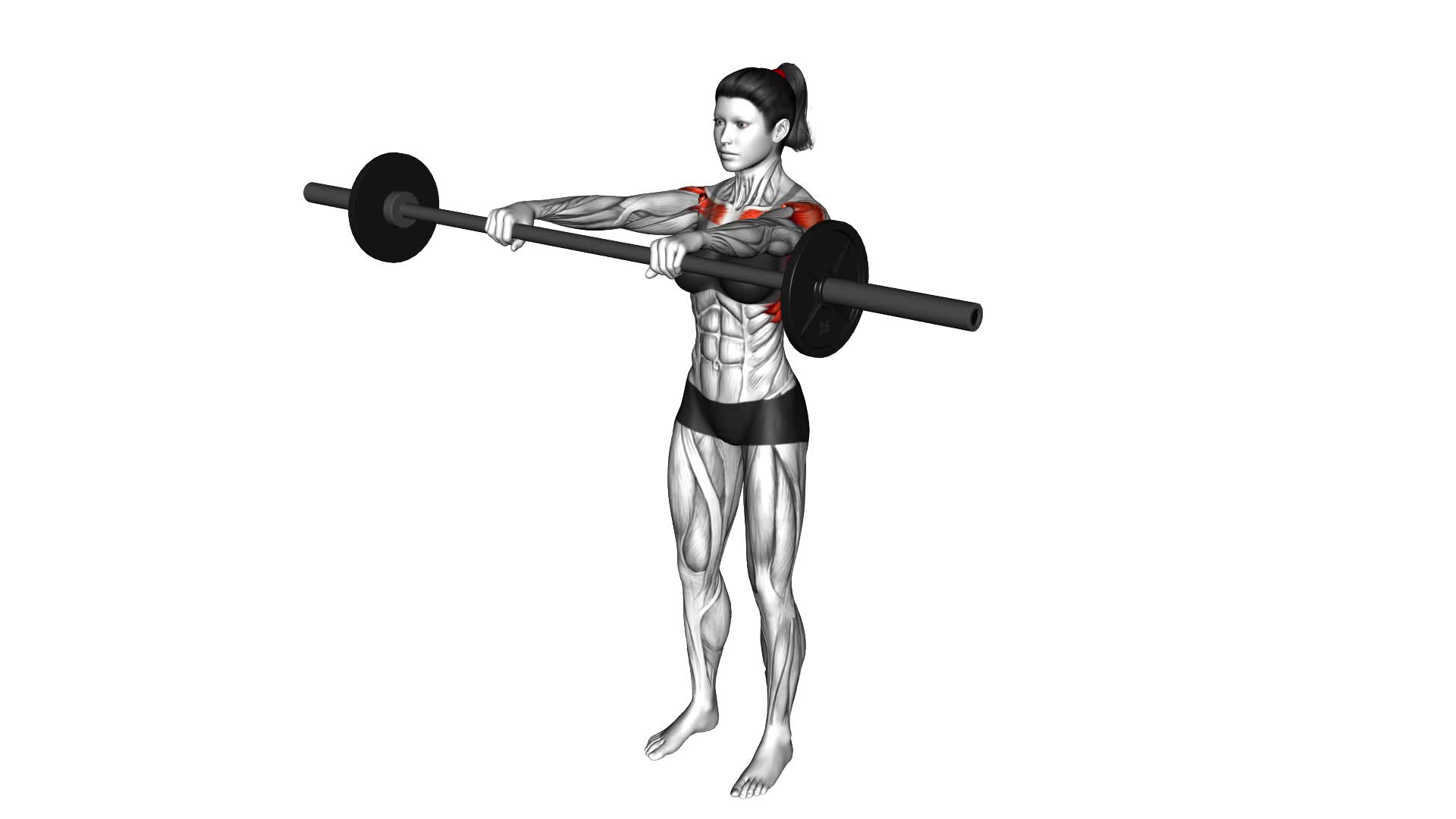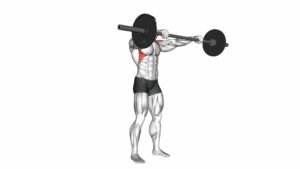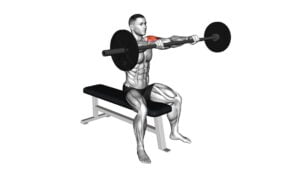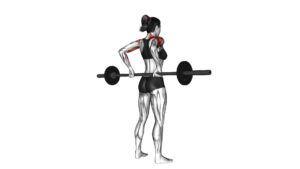Barbell Front Raise (female) – Video Exercise Guide & Tips

Are you looking to strengthen and tone your shoulders?
Watch This Exercise Video
The barbell front raise is the perfect exercise for you! In this video exercise guide, we'll show you the proper form and technique to maximize your results.
With variations and modifications available, you can tailor this exercise to your fitness level.
Learn about common mistakes to avoid and get expert tips for progression and challenge.
Get ready to take your shoulder workout to the next level!
Key Takeaways
- Barbell Front Raise targets the muscles in the shoulders.
- It helps increase shoulder strength and stability.
- The exercise improves overall upper body strength and functionality.
- Barbell Front Raise can lead to significant shoulder strength gains.
Benefits of the Barbell Front Raise
You can experience significant shoulder strength gains by incorporating the barbell front raise into your workout routine. This exercise specifically targets the muscles in your shoulders, helping to increase their strength and stability.
By regularly performing the barbell front raise, you can develop stronger shoulder muscles, which can improve your overall upper body strength and functionality.
In addition to increased shoulder strength, the barbell front raise can also help improve your posture. Strong shoulder muscles play a crucial role in maintaining proper posture, as they help support the weight of your upper body. When these muscles are weak or imbalanced, it can lead to poor posture and even pain or discomfort.
By strengthening your shoulders with the barbell front raise, you can help correct any imbalances and promote a more upright and aligned posture.
To perform the barbell front raise, stand with your feet shoulder-width apart and hold the barbell in front of your thighs, palms facing down. Slowly raise the barbell in front of you, keeping your arms straight and your shoulders relaxed. Lift the barbell to shoulder height, then lower it back down slowly to the starting position. Repeat for the desired number of repetitions.
Incorporating the barbell front raise into your workout routine can provide you with numerous benefits, including increased shoulder strength and improved posture. Make sure to use proper form and gradually increase the weight as you become stronger.
Proper Form and Technique
To execute the barbell front raise with proper form and technique, begin by standing with your feet shoulder-width apart and grasp the barbell in front of your thighs, ensuring your palms are facing down. Keep your back straight and engage your core muscles throughout the exercise.
Slowly raise the barbell in front of you, maintaining control and keeping your arms straight. Lift the barbell until it reaches shoulder level, then pause for a moment before lowering it back down to the starting position. It's important to avoid swinging your body or using momentum to lift the weight, as this can lead to improper form and decreased effectiveness.
Variations and Modifications
To explore variations and modifications of the barbell front raise, incorporate different grips and equipment for added challenge and target specific shoulder muscles. Here are some alternative exercises and equipment options you can try:
- Dumbbell Front Raise: Instead of using a barbell, hold a dumbbell in each hand and lift them in front of your body. This variation allows for more freedom of movement and can help improve muscle balance.
- Resistance Band Front Raise: Attach a resistance band to a sturdy anchor point and hold the ends in your hands. Lift your arms in front of you against the resistance of the band. This modification adds an element of instability, engaging your core muscles as well.
- Cable Front Raise: Use a cable machine with a handle attachment. Stand facing the machine and grip the handle with an overhand grip. Lift the handle in front of you, maintaining control throughout the movement.
These variations provide different challenges and can help prevent plateauing in your training. Additionally, you can also experiment with different equipment options, such as using kettlebells or weighted plates instead of a barbell.
Remember to choose the variation and equipment that best suits your fitness level and goals.
Common Mistakes to Avoid
When performing the barbell front raise, it's important to be aware of common mistakes that can hinder your progress and potentially lead to injury. One common mistake is using momentum to lift the barbell instead of relying on your muscles. Swinging the weight up not only reduces the effectiveness of the exercise but also puts strain on your lower back and shoulders. To avoid this, focus on using controlled movements and engaging your shoulder muscles throughout the exercise.
Another common mistake is lifting the barbell too high, above shoulder level. This can put unnecessary stress on your shoulder joints and increase the risk of injury. Instead, aim to raise the barbell to shoulder level, keeping your elbows slightly bent to avoid locking them out.
Improper grip is also a common mistake. Make sure to grip the barbell firmly but not too tightly, keeping your hands shoulder-width apart. This will help maintain stability and control throughout the movement.
By being aware of these common mistakes and focusing on proper technique, you can maximize the benefits of the barbell front raise while minimizing the risk of injury.
Now, let's move on to the next section for tips on how to progress and challenge yourself in this exercise.
Tips for Progression and Challenge
To increase the difficulty of the barbell front raise, gradually increase the weight you're lifting. This will help you challenge your muscles and continue making progress. Here are some progression techniques and challenging weight options to consider:
- Increase the weight gradually: Start with a weight that you can comfortably lift for 10-12 repetitions. As you get stronger, gradually increase the weight by 5-10% to continue challenging your muscles.
- Use resistance bands: Adding resistance bands to your barbell front raise can provide an extra challenge. Attach the bands to the barbell and hold onto the handles while performing the exercise. This will increase the tension throughout the movement.
- Incorporate supersets: Pairing the barbell front raise with another exercise can help to increase the challenge. For example, you can perform a set of barbell front raises followed immediately by a set of lateral raises. This will work your shoulder muscles from different angles and provide a greater stimulus.
Frequently Asked Questions
How Much Weight Should I Use for the Barbell Front Raise?
To determine the suitable weight for the barbell front raise, consider two important factors: your strength level and proper form.
It's crucial to choose a weight that challenges you without sacrificing your technique. Start with a lighter weight and gradually increase it as you feel more comfortable and confident.
Can I Perform the Barbell Front Raise With Dumbbells Instead?
Yes, you can definitely perform the barbell front raise with dumbbells instead. Dumbbells are a great substitution for barbells in many exercises. They provide a different range of motion and can help to target your muscles in a slightly different way.
If you don't have access to a barbell or prefer using dumbbells, you can try dumbbell front raises or lateral raises as alternative exercises. These exercises will also work your shoulder muscles effectively.
Is the Barbell Front Raise Suitable for Beginners?
Yes, the barbell front raise can be suitable for beginners. It's a great exercise to strengthen your shoulder muscles.
However, if you're looking for alternatives, you can try dumbbell front raises or resistance band front raises.
Remember to start with lighter weights and focus on maintaining proper form. Common mistakes in the barbell front raise include using too much weight and swinging the body.
Take it slow and steady to avoid injury.
How Often Should I Incorporate the Barbell Front Raise Into My Workout Routine?
To incorporate the barbell front raise into your workout routine, start by considering your fitness level.
For beginners, it's important to focus on proper form and start with lighter weights. Aim for 2-3 sets of 10-12 reps, 2-3 times a week.
As you progress, you can increase the weight and intensity.
Advanced lifters can try variations like the single-arm or kneeling barbell front raise to challenge their muscles in different ways.
Remember to always listen to your body and adjust accordingly.
Can the Barbell Front Raise Help Improve Posture?
Improving your back strength and maintaining proper posture can have numerous benefits.
The barbell front raise is one exercise that can help with both. By engaging your back muscles during the movement, you can strengthen the muscles that support your spine and improve your overall posture.
Proper posture not only enhances your appearance, but it also reduces the risk of back pain and promotes better alignment of your body.
Incorporating the barbell front raise into your workout routine can be a great way to work on improving your back strength and maintaining good posture.
Conclusion
In conclusion, the barbell front raise is a highly effective exercise for targeting and strengthening the front deltoids. By maintaining proper form and technique, you can maximize the benefits and avoid common mistakes.
Additionally, incorporating variations and modifications can provide a greater challenge and aid in progression. Remember to start with a weight that's appropriate for your fitness level and gradually increase as you build strength.
With consistency and proper execution, the barbell front raise can help you achieve stronger and more defined shoulders.

Author
Years ago, the spark of my life’s passion ignited in my mind the moment I stepped into the local gym for the first time. The inaugural bead of perspiration, the initial endeavor, the very first surge of endorphins, and a sense of pride that washed over me post-workout marked the beginning of my deep-seated interest in strength sports, fitness, and sports nutrition. This very curiosity blossomed rapidly into a profound fascination, propelling me to earn a Master’s degree in Physical Education from the Academy of Physical Education in Krakow, followed by a Sports Manager diploma from the Jagiellonian University. My journey of growth led me to gain more specialized qualifications, such as being a certified personal trainer with a focus on sports dietetics, a lifeguard, and an instructor for wellness and corrective gymnastics. Theoretical knowledge paired seamlessly with practical experience, reinforcing my belief that the transformation of individuals under my guidance was also a reflection of my personal growth. This belief holds true even today. Each day, I strive to push the boundaries and explore new realms. These realms gently elevate me to greater heights. The unique combination of passion for my field and the continuous quest for growth fuels my drive to break new ground.



